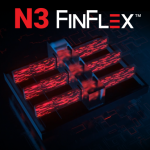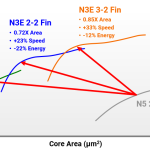Recently, TSMC held its annual Technology Symposium, revealing the future of process node technology, which will power processors in the generations to come. TSMC had a couple of major advancements to show off, including its new Finflex technology for N3 and N3E, and the new N2 node with new transistor technology.
As per TSMC, the N2 node is the next big breakthrough after N3. Bringing a speed improvement between 10% and 15% at the same power or a 25-30% power reduction at the same speed, the new N2 node promises to offer yet another generational leap with it. The new manufacturing process will use a nanosheet transistor architecture and feature a high-performance variant, a mobile version, and a chiplet-oriented solution.
Moving on to Finflex, TSMC's new technology promises to bring more flexibility to customers through three different configurations. These are the 3-2 fin configuration for high-performance parts, the 2-1 fin configuration for maximum efficiency and transistor density, and the balanced 2-2 fin configuration. This new technology will be available for N3 and N3E process nodes, allowing customers to create solutions based on their needs.
Besides N2 and the new Finflex tech, TSMC also talked about the successor of N12e. As part of TSMC's Ultra-Low Power platform, the new node is aimed at edge AI and IoT devices. Moreover, it will be based on the 7nm process, offering three times more logic density than its predecessor. Lastly, the semiconductor company stated that support for CoW (Chip-On-Wafer) and WoW (Wafer-On-Wafer) stacking is coming to the N5 node in 2023.
Discuss on our Facebook page, HERE.
KitGuru says: Considering N3/E Finflex will enter mass production later this year, the first actual products based on the new configurations should release in 2023. It is going to take a while longer to get to N2, which is slated for 2025.
 KitGuru KitGuru.net – Tech News | Hardware News | Hardware Reviews | IOS | Mobile | Gaming | Graphics Cards
KitGuru KitGuru.net – Tech News | Hardware News | Hardware Reviews | IOS | Mobile | Gaming | Graphics Cards





